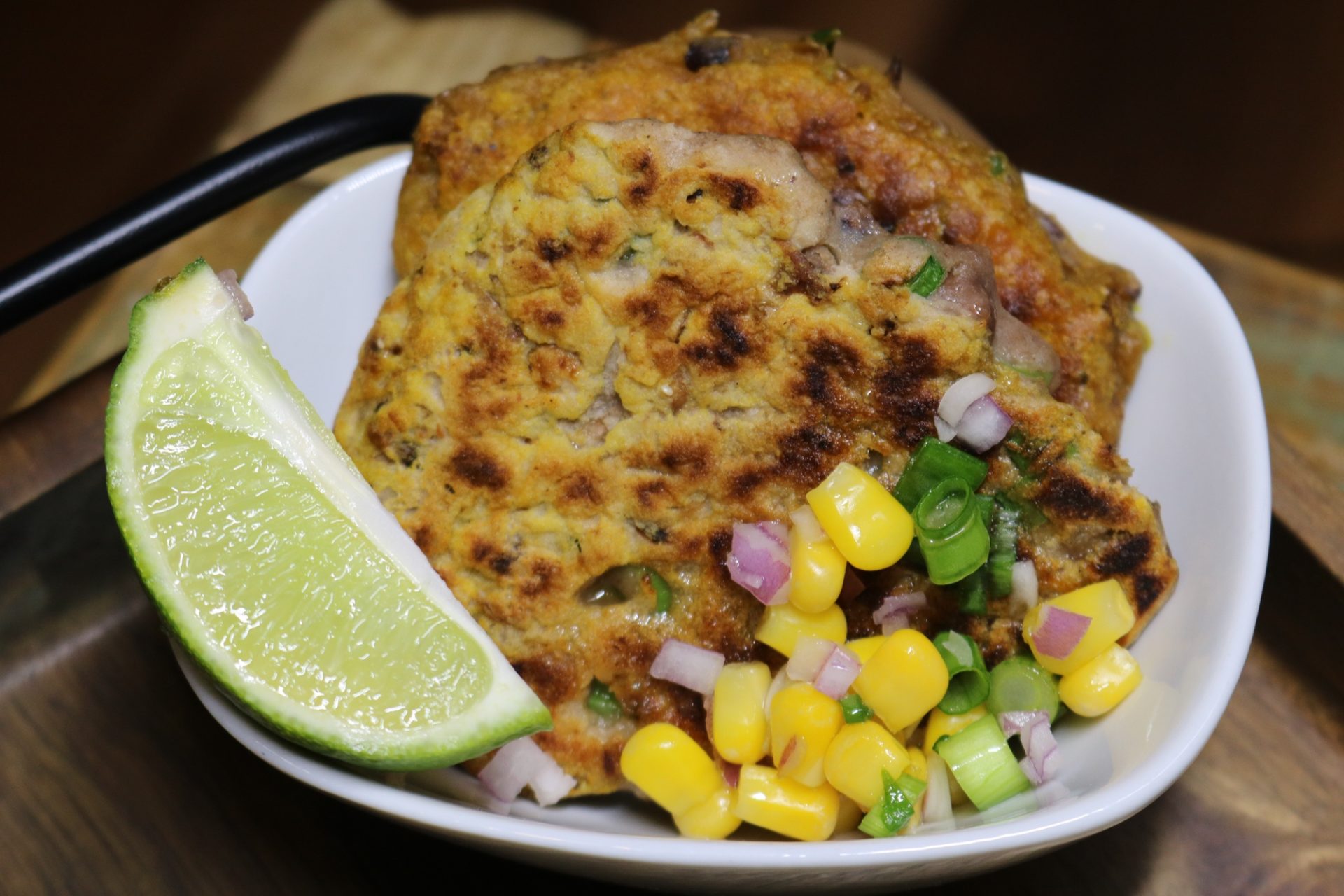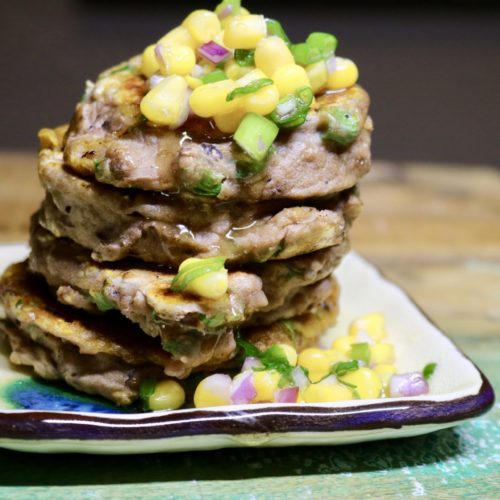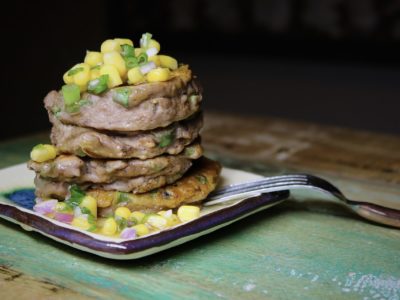Last Updated on June 29, 2022 by Rebecca Huff
New and tasty, these black-eyed pea fritters with corn salsa will help you get out of your regular bean rut!
When I was a child, we ate black-eyed peas on New Year's day, and that was pretty much the only time they appeared on my plate. As an adult, however, I found out that I enjoy eating them more often. My favorite tamale contains black-eyed peas, oh so yummy!
Do you use black-eyed peas regularly?
Recently, I started incorporating more legumes in my diet as they are rich in fiber. Black eyed peas have become a more frequent star in my home-cooked dishes as well.
If you don't already, when you realize how amazingly healthy black-eyed peas are, you'll start incorporating them into your meals more often.
On a side note, black-eyed peas are in the bean and pea family, so while they are called “peas”, they are a bean, and both peas and beans are legumes.
[Tweet “Black eye peas have many incredible health benefits, so incorporate more of them into your diet.”]
Benefits of black-eyed peas
Black-eyed peas are a good source of protein, fiber, and iron! Half a cup contains around 2.2 mg of iron, which helps to prevent anemia, and the fatigue that comes with it!
A half-cup of cooked Black-eyed peas contain about half of the daily recommended intake of Folate and around 239 mg of potassium. If you need to watch your blood pressure, you will be happy to know that the potassium in black-eyed peas will help out!
You may be surprised to find out, black-eyed peas contain around 25% of your daily recommended amount of Vitamin A, a vitamin normally found in sweet potatoes, carrots, red bell peppers, etc. Vitamin A in black-eyed peas will keep your skin healthy and also support healthy eyes.
Black-eyed peas are full of fiber and can help you to feel full faster, contributing to weight loss. Eating more fiber can also reduce your risk of metabolic syndrome and diabetes. Eating more fiber-rich black-eyed peas can help to lower blood cholesterol levels and, in turn, reduces your risk of heart disease.
Black-eyed peas contain soluble fiber, which can lower LDL cholesterol without disturbing the protective HDL cholesterol levels.
The fiber in black eye peas combats constipation and other digestive tract issues, including colon cancer.

Side-effects of eating black-eyed peas
So, when you start eating more black eye peas, keep in mind that you may want to start with small amounts and work your way up. Unless you're already used to having several servings of fiber per day.
Suddenly increasing your fiber intake can cause some bloating, gas, or more frequent bowel movements. If that's you, consider making these as an appetizer until you've worked up your tolerance to beans and fiber. They also make a great side dish paired with Salt Block Salmon and Tzatziki Bowl.
The insoluble fiber in black eyed peas absorbs water, causing stools to swell, which in turn can put pressure on the intestines to expel faster. A good thing for your health, but it can be uncomfortable if you're not used to eating much fiber.
One helpful idea is to be active after eating black eye peas. Taking a walk after you eat can help with any discomfort from increasing your fiber intake.
Ingredient substitutions
If you follow a gluten-free lifestyle, feel free to use a flour blend that works with your diet. I have made these using a combination of coconut and pecan flour with good results. When subbing out other flours for wheat, add less than the full amount and add more until you reach a good consistency. The mixture should not be thick enough to roll into a ball but not so runny you can pour it either.
If you're a fan of cilantro, feel free to add some to the corn salsa. Hot sauce also works well with these if you like spice. My kids love spicy food, so I often add red pepper flakes, a teaspoon cayenne, or a few dashes of hot pepper sauce. As with all my recipes, I suggest you play around with spices you like to suit your own taste preferences.
Preparation tips:
Using a food processor can cut down on prep time. Simply blend the black-eyed peas and flour first. Then use a spoon to stir in the green onions and spices so as not to puree them.
Prep time can be kept to a minimum if you drop them by the spoonfuls and then use the back of the spoon to press them down a little.
If you like more neatly rounded patties, keep a large bowl with a cup water nearby. Dip your hands in the water, and use the palms of your hands to pat these into perfect round patties. When I do this, I use just a touch of cornmeal mixed with salt and ground black pepper to lightly coat them before I add them to the pan.

Black-eyed pea fritters with corn salsa
Ingredients
- 3 cups black eye peas or 2 – 15.5 oz cans
- 1 bunch green onions sliced thinly (save 2 tablespoons of sliced green onions for the corn salsa)
- 3/4 – 1 cup flour you can use gluten-free flour if you prefer, it works just fine
- 1 egg lightly beaten
- 2 teaspoons of oil for pan
- Salt and pepper to taste
- 1 tsp tandoori masala powder optional (use whatever seasonings you prefer)
- Corn Salsa
- 1.5-2 cups corn kernels fresh, uncooked is my favorite but frozen or canned works fine
- juice and zest from one lime
- 2 tablespoons honey
- 2 tablespoons sliced green onions saved from fritter ingredients
- diced purple onion optional
- salt and pepper to taste
Instructions
- In a separate bowl mix lime juice, honey, salt and pepper, stir well.
- Add corn and green onions – stir and let sit while the fritters cook.
- To cook black-eyed pea fritters
- Mash black-eyed peas with a potato masher until semi-smooth, it will still have a few chunks of beans
- Mix in flour, egg, green onions, and seasonings.
- Add a small amount of oil to the pan to keep fritters from sticking.
- Scoop 1/3 cup portions of mixture onto the pan, fry till lightly browned, then flip, frying the second side until brown.
- Remove to plate, top with corn salsa.
Notes
Cooking Black-Eyed Pea Fritters
I use all-purpose flour or gluten-free flour without baking soda or baking powder, or salt. If all you have is self-rising flour, no worries, they'll just be a bit fluffier and cakier than normal.
I typically use my cast-iron skillet and a small amount of coconut oil over medium-high heat to get them crispy on the outside. We're not deep-frying the, just enough oil to get the outside golden brown. (I don't use vegetable oil or olive oil for frying and here's why.)
Heat oil before adding the patties to the pan. Work in batches and don't overcrowd the pan. Cook until crispy and golden brown on both sides. Then use a slotted spoon to remove the fritters from the pan and let them rest on a cookie rack. (or paper towels if you use them.)
If you follow the THM diet and want to separate carbohydrates from fats, put these on a baking sheet instead. You'll bake at 350 degrees for 15-20 minutes. My air fryer also does a fine job of creating a crispy coating.
Black-Eyed Pea Fritter Notes:
Instead of using black-eyed peas in cans, I like to buy them dried and cook them in my instant pot. If I make a large bag of black-eyed peas, I can make a stew with some and have plenty left over for fritters. A small bag, 12-16 ounces is just right for this recipe.
Also, be adventurous with seasonings, Chinese Five Spice is a good blend to try as well as curry and cumin. Try different seasonings and toppings. These also taste great with a bit of Munster cheese melted on top or crumbled goat cheese.
If you enjoy black eyed pea recipes, try my Smoky Chicken Tostados with Black Eyed Peas and Chile-Lime Salsa.
Enjoy!



 Delicious Fried Fish Made with Wild-Caught Cod
Delicious Fried Fish Made with Wild-Caught Cod
Leave a Reply
You must be logged in to post a comment.